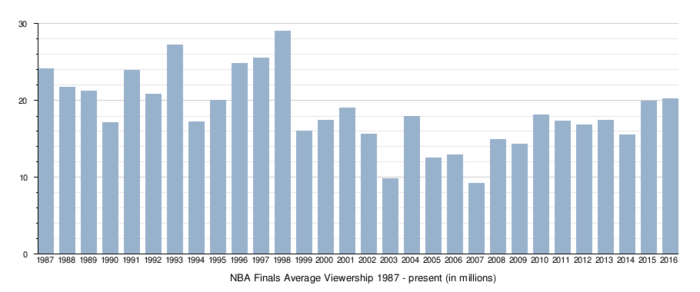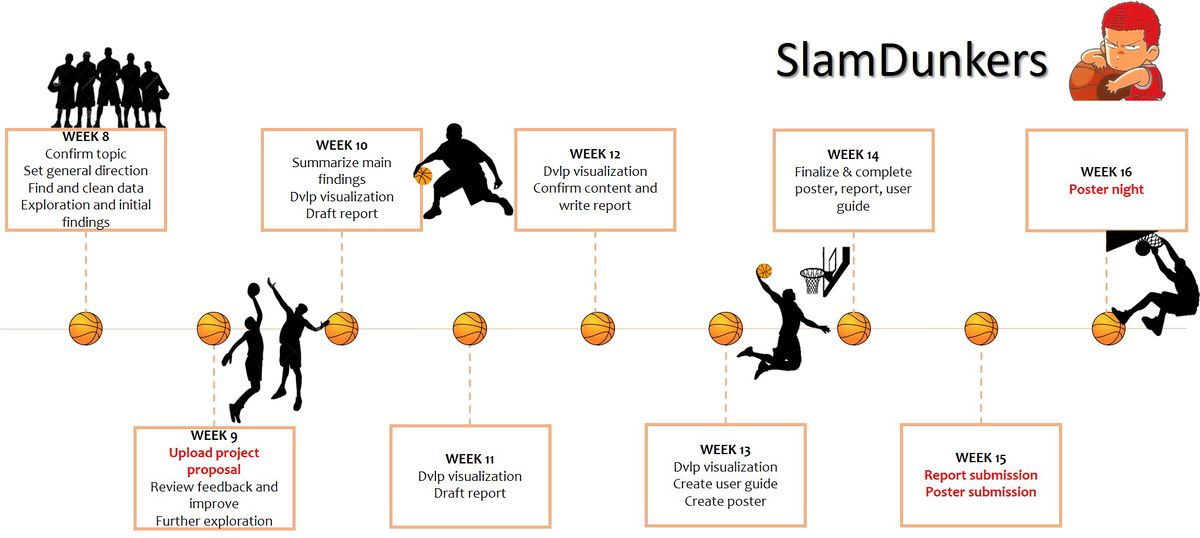Slamdunkers Proposal
The National Basketball Association (NBA) is the pre-eminent men's professional basketball league in North America, and is widely considered to be the premier men's professional basketball league in the world. It is considered to be one of the four major sports in the United States and Canada. According to an article by Business Insider, NBA is the highest-paying league in the world. Numerous star players such as Kobe Bryant, Lebron James and Kevin Durant are among the world’s highest-paid sportsmen listed by Forbes in 2016.
In attempt to win the championship each season, NBA teams spends a large sum of money on players' salary. It is in each team's best interest to recruit the best players with the limited resources they have. Before the start of each season, each team will negotiate with the players to represent them for the season. They look for the best fit players in term of their skills, abilities and past statistics to get the best optimal formation. Better understanding of the players’ statistics can help coaches to focus their resources on the player's strengths.
A player performance tool could assist coaches to better analyse the players. By comparing the past players’ statistics, they could better understand each player’s strengths and weaknesses. The tool provides players’ performance by looking at their statistics (e.g. total number of shot made per game) and the game’s statistics (e.g. the remaining time left of each shot).
In this project, we aim to provide a visualisation for coaches to perform the following:
- To gain a better insight of the players they are interested in.
- To make comparison between players
- To identify the players’ strength and weaknesses
- To be able to make strategic game changing tactics by looking at the performance of players at different periods of the games.
Our selected dataset is downloaded from Kaggle. The original data is extracted from the NBA of ESPN by using the REST API. The data is based on the NBA 2015-16 season.
The rationale for the range of data used for our analysis are as follow:
- The data contains 128069 records of shots made in the season. With the detailed information, it allows us to carry out more accurate analysis based on each shot.
- The attributes is based on the statistics of the players and games. It enables us to find out how each player performed in different periods of the game.
The table shows the data dictionary of the dataset.
| Label | Description |
|---|---|
| Game ID | Identification number of each game |
| Date | Date of game |
| Player Team | Player's team |
| Opponent Team | Opponent team |
| Home/Away | If player's team is on home ground |
| Win/Lose | If player's team win or lose |
| Game Score Difference | Difference in total game score |
| Shot Number | N-th shot made by the player |
| Period | Period of the game when the shot was made |
| Game Clock | Game time when the shot was made |
| Shot Clock | Shot time when the shot was made |
| Dribbles | Number of times the player dribbled before the shot was made |
| Touch Time | Total time held by the player before the shot was made |
| Shot Distance | Distance from the basket when the shot was made |
| Point Type | If shot attempt is 2 or 3 points |
| Shot Result | Result of the shot |
| Closest Defender | Name of the closest opponent defender |
| Distance from Closest Defender | Distance between player and the closest opponent defender when the shot was made |
| Field Goal Made | If a goal was made |
| Points | Points earned by the player's shot |
| Player Name | Name of the player who made the shot |
| - | Description |
|---|---|
|
NBA Viewership The average viewership of National Basketball Association (NBA) have reached an record of 20.2 million viewers, the highest ever since the golden Michael Jordan era of 1998. Much of this can be attributed to the growing popularity of the action-packed game where either team can score in an amazing and athletic manner. This is coupled with cult figures such as Stephen Curry and LeBron James, who constantly show up with their basketball trickery in big games. However for basketball lovers, it is often different and frustrating to analyse the different aspects of the game quantitatively. There is a lack of available platform in the realm of basketball where interactive visualizations exist for fans to compare the different abilities of various players. There are also no platforms for fans to observe the patterns of how their favorite players play according to individual positions and roles. Hence, there is a strong motivation to provide real-time and up-to-date information about the different aspects of the game. |
Our approach is to first consider the questions that a coach would ask when scouting for players. These questions include:
- Who are the good shooters?
- What is the most comfortable distance player can shoot from and get a goal? (distribution? precision?)
- Who are the good blockers?
Afterwards, depending on what kind of game tactics that the coach would want to employ, he may consider other questions.
- Is player’s performance consistent during the whole game?
- When does player performance peak?
- Is there a difference in player’s performance when playing on home or away ground? What are the differences?
With these questions, we shall perform some data exploration to get some insights to these questions.
Unfamiliar with visualization softwares
- Start creating visualizations early
- Look up online resources
The steep learning curve of D3.js
- Start early
- Work with tutorials and examples
Motivation
- NBA is the highest-paying league in the world. [1]
- The world’s highest paid athletes [2]
- NBA player salaries [3]
Dataset
| Member | Job scope |
|---|---|
| Alson TAN Yong Kiong aka SlamDunker 1 |
|
| Arnold LEE Wai Tong aka SlamDunker 2 |
|
| LIM Lai Ho aka SlamDunker 3 |
|
Feedback and comments in this area!


